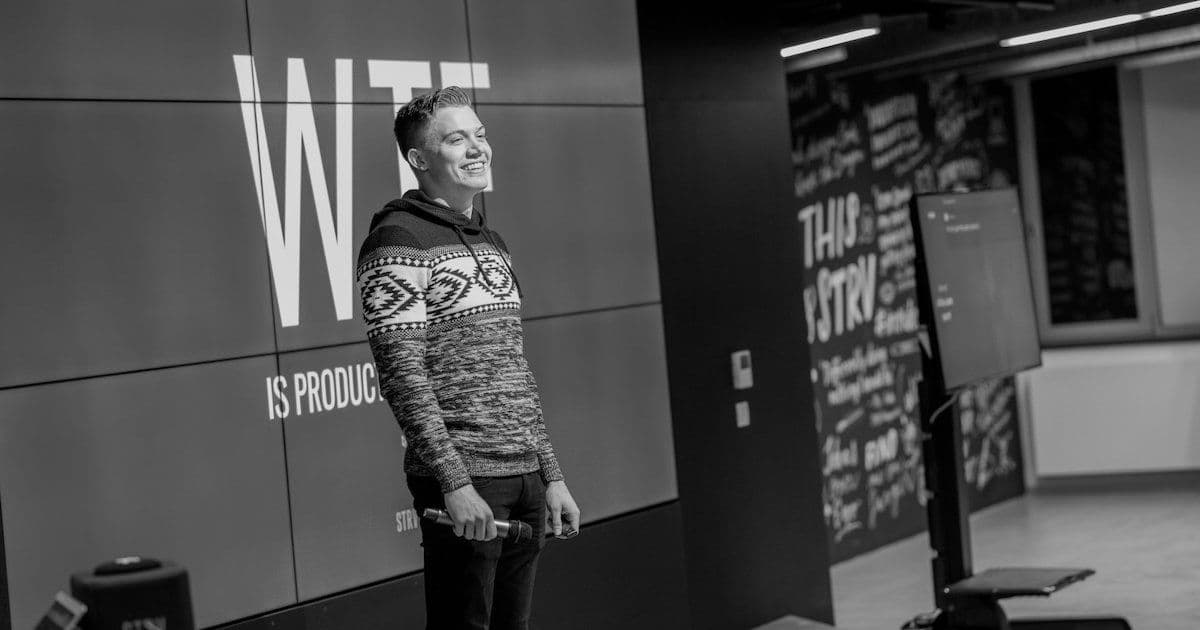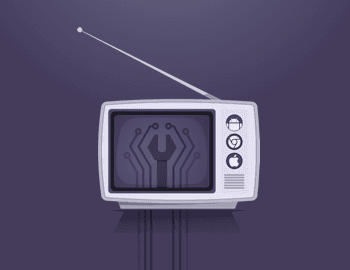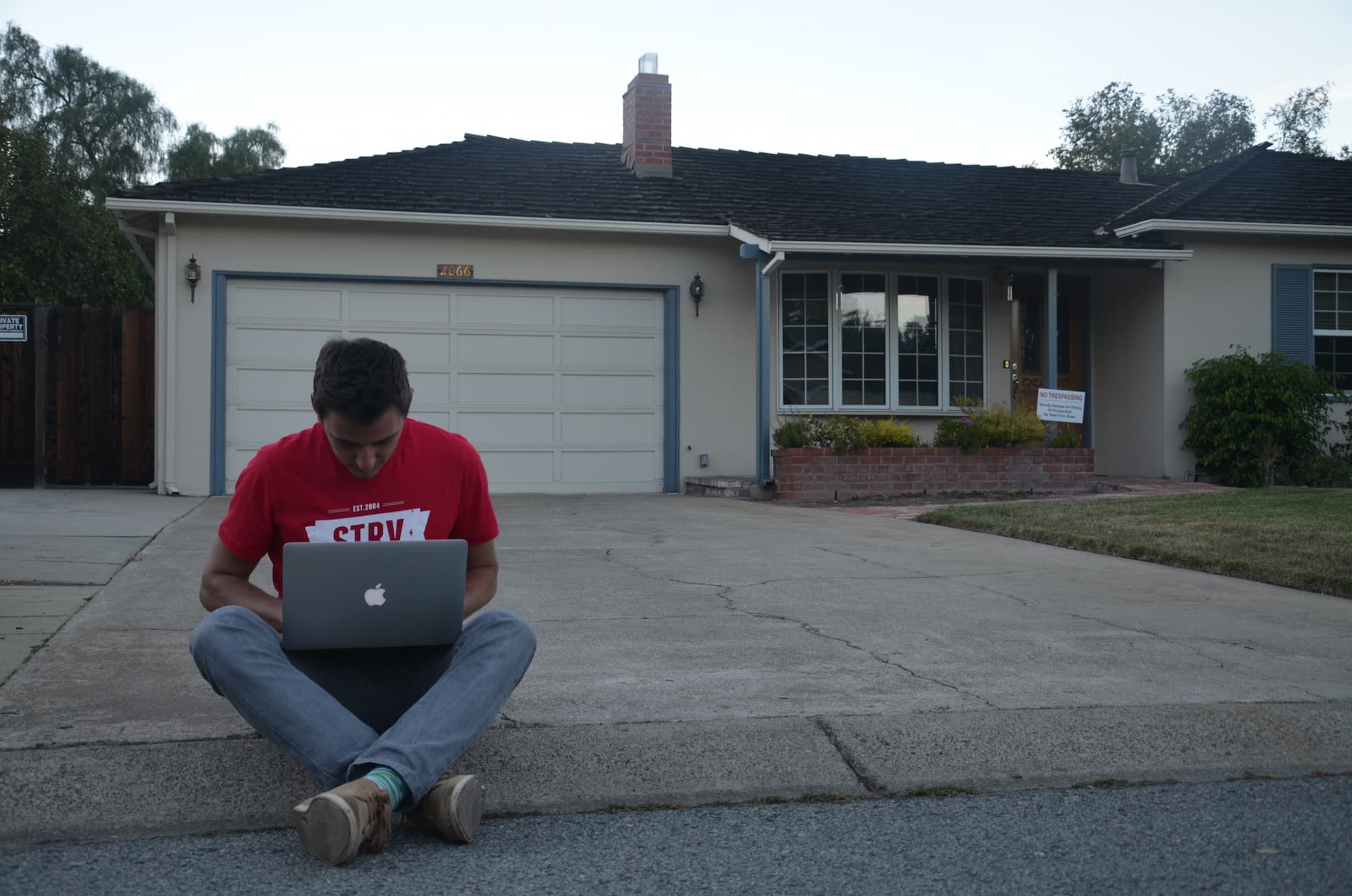At STRV, there’s a PM paving the way from the beginning. From discussing an idea with a new client and establishing the right approach, all the way to a successful product launch – a PM filters through feedback and rearranges priorities to keep projects on track.
What does that include, exactly?
To summarize:
“A manager’s top responsibility is to shield all the bullshit that happens at work from the people that need to do the work,” says Evan Sendra – our Head of Delivery – quoting Jason Fried.
Having started at STRV as a project manager in 2017, Evan has gone on to transform the delivery department into a more proactive team focused on true project and product management.
With a strong grasp of a PM’s daily agenda here at STRV, he shares what you can expect if you join the growing team, or if you decide to collaborate with us.
Our product team organizes events for the community.
What is STRV’s client base for product management?
Our clients are mainly startups from Silicon Valley. They need help building their products from scratch to MVP. That’s where we come in. We’ve worked with clients like Boosted Boards, Dash and ClassDojo. What excites us the most is the process of working with passionate founders who can’t wait to ship products to real users.
Can you describe some of your favorite projects?
We helped Boosted Boards engage their massive community of electric skateboard enthusiasts by building a mobile app experience around the awesome devices they’ve already built. With Dash, we rebuilt the platform they use to vote how their crypto community will allocate its budget for future Dash development!
How many different projects can a product manager handle in one year?
A product manager may easily lead 5 products to launch over the course of the year while assisting in building several others. When a prospect is close to signing with us, the project is discussed with PMs to determine who is most interested – and most qualified – to handle the given client, as well as who has the capacity to take on another project. This way each PM gets to do work they like, and can often specialize in particular types of clients.
Can you detail all forms of interaction you have with clients?
Due to a significant time difference with most of our clients (9 hours from SF/LA to Prague), we prefer morning meetings (pacific time) that don’t bleed into the late hours in Prague.
During meetings, we inform clients of progress made and they can bring up any deliverables needed for our team. We’ve found this remote working setup efficient, as it keeps everybody up-to-date.
Of course, in crunch time or when kicking off a larger project, we may fly a team/team member out on-site to meet with the client and set everything up for success. Sometimes it’s necessary to avoid even the smallest lag in communication caused by remote work.
Our typical approach is: We first work with the client over a period of 4-6 weeks to help them define what product they want to build. This involves day-to-day interaction with the client via chat and email, as well as weekly or more meetings. Results delivered in this phase are full product specs, a product roadmap, UX wireframes, product design concepts, a timeline and a budget estimate.
After the strategic deliverables are produced and agreed upon with our client, we’ll run pretty standard agile sprints or iterations running by default in two-week cycles. Within each iteration, we start with backlog grooming and planning, then proceed to have daily written updates from the design, engineering and QA teams, ending the sprint with a review of what is complete and, ideally, a demo of what has been accomplished.
When was the last time you said “no” to a client, and why?
We recently had a client request a feature that would potentially double the scope of the project. For us it seemed like a silly request, but clients don't always know the technical implications of what they are asking for. We simply had to explain that the feature would not be implemented in the time frame they were hoping.
Usually, a simple and thorough explanation of the real product challenges or implications are enough to stop scope creep or timeline/budget overages.
How does the product management team work with engineering, design and clients?
Product management gets involved during the sales phase, as we detail what we are to create for our clients. From there, we work with design and engineering to decide which team is best for the project. As already mentioned, this decision is based on interest, skills and availability – typically, we prefer keeping every designer, engineer or QA engineer working on no more than one project at a time.
PMs work to make sure that requests coming from all angles – client, sales, design, engineering, or some combination – remain feasible and can be done while keeping in mind all project constraints. In many ways, being a good PM means pissing the right people off at the right time to ensure that the final output has maximum value.
Throughout product development, a big part of the job is monitoring the team assigned. A PM ensures motivation stays high while solving problems as they come up. Since STRV is rather transparent, it’s not uncommon for PMs to pull leads from engineering into the conversation at any given time, or to give kudos for a job well done day-to-day. Ultimately, we’re all seeking to build the most value for the client given the constraints at hand, so PMs at STRV “lead from the back” – to quote the great Nelson Mandela.
What PM tools do you use?
We’re working to expand the PM tools we regularly use, but right now these are the must-haves on our team!
How many people does the product management team at STRV include? Do you plan to grow?
Currently, the Delivery department consists of 4 project managers and 3 product managers. We’re looking to expand our team of 7 to 12 by the end of 2019, and we’re always hiring humble, compassionate, scrappy PMs. Join us here!
Meet the members of the delivery team: Evan, Michal, Fedor and Kate.
What is the hardest thing about being a product manager at STRV?
Probably having to say no to excellent ideas. Many times, designers, developers and QA engineers have great product ideas, but due to budgetary or timeline restrictions they don’t make it to the final product launch.
Can you share a lesson learned from the last product launch?
From the estimation stage on, it’s important to consistently clarify and ask questions. When launching a pair of apps to the App Store and Play Store for one of our clients, we realized that there was a severe interoperability issue with the Bluetooth chipset being used and the Android Operating System. Since the client had already shipped the hardware, and we had estimated and agreed on a timeline, there was little that could be done other than keeping all stakeholders informed of delays.
That said, dissecting this issue quickly led us to realize the importance of a comprehensive approach when researching prospective client hardware.
Getting a job as a product manager is now more competitive than getting a job as a software engineer. What should prospective PMs do to rise above the competition and get their dream job?
Ship things! Showing that you’ve shipped products in the past and therefore directly contributed to driving product KPIs is the number one thing that makes your resume stand out. A close second is improving the working lives of those around you.
To quote Jason Fried, “A manager’s top responsibility is to shield all the bulls**t that happens at work from the people that need to do the work”. It’s also good to follow some resume best practices to present oneself in the best light.
Kate Douskova - Product manager
Should a product manager be a decent coder?
It certainly helps in some aspects of the job to be a decent coder, but many PMs on our team have never coded and still do an excellent job. The barrier to entry of a product management job is being able to empower teams to ship things. That requires much more than just technical skills.
That said, if you are organized, intelligent, curious, empathetic and socially savvy already, knowing the basics of how to code is a great way to stand out and will help to empathize with development teams!
How do you onboard new product managers?
Our onboarding is a bootcamp completed by the new team member over his/her first week. He/she is given a list of tasks and names of people with whom to grab coffee, as well as a mentor. The new member is expected to complete every task on the list, from finding out how our department supports invoicing to how agile is setup by default at STRV.
Everything is self-directed, but mentors are ready to support and open to any and all questions. We’ve found that this allows our new teammates to get to know the people, company, logistics, and process quickly and efficiently – without the hassle of long, boring onboarding presentations. STRV isn’t a fan of boring.




